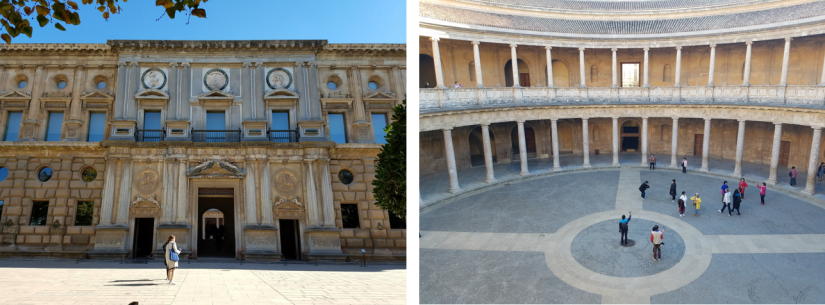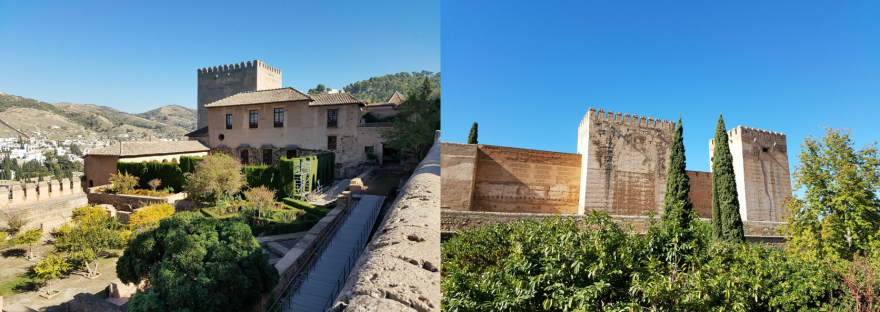Our visit to the “Alhambra” began entering the great fortress or citadel. This reminded us of our own walled city of the Old San Juan in Puerto Rico.
We began completely enjoying this visit as we strolled  through the “Medina”. We advanced towards the Nasrid Palaces at the scheduled hour, leaving behind us the Church of “Santa María de la Alhambra” and the “Palacio de Carlos V”, among other things. While waiting on line, we were able to enjoy the view of the “Patio de Machuca”.
through the “Medina”. We advanced towards the Nasrid Palaces at the scheduled hour, leaving behind us the Church of “Santa María de la Alhambra” and the “Palacio de Carlos V”, among other things. While waiting on line, we were able to enjoy the view of the “Patio de Machuca”.

 The Nasrid Palaces is actually comprised of; “El Mexuar”, the “Palacio de Comares” and the “Palacio de los Leones”. The latter is perhaps the most recognized worldwide and associated with the “Alhambra”. Each palace has diverse rooms, halls and patios with their fountains.
The Nasrid Palaces is actually comprised of; “El Mexuar”, the “Palacio de Comares” and the “Palacio de los Leones”. The latter is perhaps the most recognized worldwide and associated with the “Alhambra”. Each palace has diverse rooms, halls and patios with their fountains.
Our tour of these palaces started with the “Mexuar” which has impressive plasterworks, the first of many more we would find. We continued on to the “Torre de Comares” and the “Arrayanes” patio encountering the “Baños de Comares”.



So much to see, so many beautiful elements to notice. The “Sala de Dos Hermanas”,the “Lindaraja” patio, the “Peinador de la Reina”, the “Despacho de Carlos V”, the Hall of Kings, the “Sala de los Abencerrajes”, the “Harem” patio and in the center of it all, the Lion’s Patio (“Patio de los Leones”) with its renown fountain. Simply Spectacular!


Upon exiting the Nasrid Palaces we encountered the “Partal” Palace with its “Torre de Damas” and Oratorium in front of another garden and of course, more fountains.

Our tour to fully enjoy the Nasrid Palaces lasted about an hour and a half.
To enjoy more photos of “La Alhambra, follow this link: “La Alhambra”
“La Alcazaba”:
Concluded our visit to the Nasrid Palaces,  we took a brief break in the surroundings of the “Puerta del Vino” (adjacent to meal concessions, rest rooms and souvenir shop). As we waked through the “Puerta del Vino”, we discovered the “Alcazaba” and the grand “Placeta de los Aljibes” (the Cistern Plateau).
we took a brief break in the surroundings of the “Puerta del Vino” (adjacent to meal concessions, rest rooms and souvenir shop). As we waked through the “Puerta del Vino”, we discovered the “Alcazaba” and the grand “Placeta de los Aljibes” (the Cistern Plateau).
Despite the “Alhambra” being located near the banks of the Darro River, transporting water from the river to the hilltop of the “Sabika” was not an easy task. This is one of the reasons for having cisterns through-out the complex. The “aljibe” (from the Arab language) is a resource for storing water or cistern, usually of rain water for drinking purposes.
Notwithstanding, it is precisely the Darro River which is the main provider of water to complex by means of the “Acequia Real de la Alhambra” (Royal Irrigation Ditch). Modeling after the Roman’s hydraulics of capturing water from this same river which was used to deliver water to the gold mines of “Cenes”, the Moors created a similar manner of making water available to the Alhambra.
We also learned that what is now known as the “Placeta de los Aljibes” was in truth a deep ravine which separated the “Alcazaba” from the Nasrid Palaces. The Count of “Tendilla” used the ravine to construct new and larger cisterns in 1494.
A high wall separates the “Placeta de los Aljibes” from the main fortress (now we know why) and immediately we made our way to the “Torre del Homenaje” (Tower of Homage) nearby the “Puerta de Tahona”. From this vantage point we could view the “Sierra Nevada”, the “Sacromonte” and the “Albaicín”. We gained a more spectacular view atop the “Torre del Cubo”! From here we could see (and even waved hello) at a distance, the crowd at the “Mirador de San Nicolás” located in the ““Albaicín”. This was an excellent spot to take pictures.

Our tour of the “Alcazaba” took us further through the “Plaza de Armas”, the “Barrio Castrense”, the “Torre de la Vela”, the “Torre de Pólvora”, and descend to the “Adarves” Garden. After spending over an hour discovering the “Alcazaba”, we returned to continue seeing the “Alhambra”.

The Charles V Palace (“Palacio de Carlos V”) is an impressive structure which interconnects with the Nasrid Palaces. Its rectangular shape hides the circular interior patio within. Incidentally, part of the “Palacio de Comares” was demolished in order to build this palace. However, contrary to an ancient practice, the Charles V Palace was built adjacent to the Nasrid Palaces and not upon the ruins of a conquered nation.

Our visit continued with the viewing of several archaeological sites, the “Santa María” Church, and the San Francis Convent. Strolling through the “Medina” we arrived at the “Puerta de los Siete Suelos” to enjoy another view of the same and its interior. We walked through lovely gardens as we approached the most extensive grounds of the complex, the “Generalife”.

